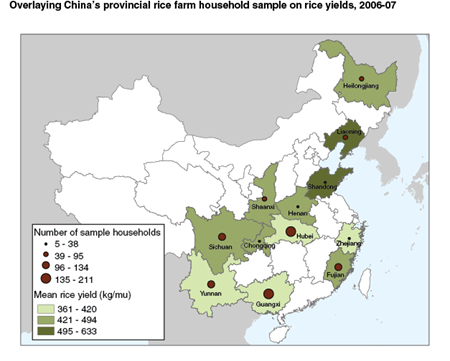The Impact of Migration on China’s Rice Production

The great Chinese migration from farms to cities during the past several decades ranks among the most economically consequential of modern population movements. China’s policymakers have long assumed an abundance of labor in rural areas and crafted policies to promote the migration of labor from rural areas to cities to help fuel China’s industrial growth. In recent years, rising wages and seasonal labor shortages have raised doubts about the validity of that assumption in present-day China. Some researchers believe that China’s abundant supply of rural labor has been exhausted, citing frequent seasonal labor shortages in urban manufacturing centers, rising urban wages, and the fact that more than 46 percent of China’s population is now living in cities for more than 6 months a year. However, empirical evidence based on national data suggests that a large amount of labor remains to be shifted from agriculture.
The question of whether surplus labor continues to exist in rural China has significant implications, especially for national food security. China’s policymakers consider food security to be the top-most important policy goal and necessary for success in other areas of economic development. To meet estimated national consumption requirements in 2020, China has announced a target of a 9-percent increase in grain production—or 45 million tons—over 2008 levels. If China is no longer operating under a surplus labor model of economic development, the country’s policymakers may face a tradeoff between supplying labor to meet grain production targets and supplying labor to achieve the Government’s policy goals in other sectors of the economy. Consequently, there will be growing needs for farmland market reforms and modernization of China’s labor-intensive, fragmented farming systems.
ERS researchers used farm household production data to test the existence of surplus labor in China’s agricultural sector. Using a 2006-2007 survey of rice-producing households, data reported across 12 Chinese provinces, and a new economic modeling approach, researchers examined the impact of rural-to-urban migration on agricultural production and how farmers coped with lost labor. Findings point to a persistence of surplus labor in Chinese rice-producing households, albeit in the form of underutilized labor capacity. Specifically, their comparison of farms showed no statistically significant effect of family members’ outmigration on the number of days family laborers worked in rice production. Thus, farm households have coped with the exit of migrant labor by reducing leisure time and other, lower return sideline farm activities. Moreover, a household member’s decision to migrate does not seem to have substantially reduced the household’s total rice production—every 100 person-days of migrant labor withdrawn from a rice-producing household has been shown to reduce rice yields by 4 kg per mu, or less than 1 percent of the sample-average rice yield (1 mu = 0.165 acre). Since the income of migrant workers is far higher than the lost farming income, migration remains a powerful engine of income growth and poverty reduction in rural China.
Findings further indicate that China’s rice-producing households did not invest migrant remittances in labor-saving farming technologies: income from migrant labor only slightly boosted chemical use and had no effect on expenditures for animal draft power or machinery services. While the stability of rice production amid significant rural-to-urban migration is good news to China’s economy, the lack of productive on-farm investments in the face of rising off-farm income is a concern for meeting its long-term national food security targets.
“Impacts of Migration on Household Production Choices: Evidence from China”, Journal of Development Studies, Vol. 50, No. 3, pp. 413-425, April 2014


